Alprazolam
Editor-In-Chief: C. Michael Gibson, M.S., M.D. [1]; Associate Editor(s)-in-Chief: Sheng Shi, M.D. [2]
Disclaimer
WikiDoc MAKES NO GUARANTEE OF VALIDITY. WikiDoc is not a professional health care provider, nor is it a suitable replacement for a licensed healthcare provider. WikiDoc is intended to be an educational tool, not a tool for any form of healthcare delivery. The educational content on WikiDoc drug pages is based upon the FDA package insert, National Library of Medicine content and practice guidelines / consensus statements. WikiDoc does not promote the administration of any medication or device that is not consistent with its labeling. Please read our full disclaimer here.
Overview
Alprazolam is a Benzodiazepine that is FDA approved for the treatment of anxiety disorders,panic disorder. Common adverse reactions include decrease in appetite,increased appetite,weight increased,constipation,reduced salivation,xerostomia,cognitive disorder,confusion,dysarthria,incoordination,lightheartedness,memory impairment,sedated,somnolence,irritability,reduced libido,fatigue.
Adult Indications and Dosage
FDA-Labeled Indications and Dosage (Adult)
Anxiety Disorders and Transient Symptoms of Anxiety
- Dosing information
- 0.25 to 0.5 mg PO tid. The dose may be increased to achieve a maximum therapeutic effect, at intervals of 3 to 4 days, to a maximum daily dose of 4 mg, given in divided doses. The lowest possible effective dose should be employed and the need for continued treatment reassessed frequently. The risk of dependence may increase with dose and duration of treatment.
- In all patients, dosage should be reduced gradually when discontinuing therapy or when decreasing the daily dosage. Although there are no systematically collected data to support a specific discontinuation schedule, it is suggested that the daily dosage be decreased by no more than 0.5 mg every 3 days. Some patients may require an even slower dosage reduction.
Panic Disorder
- Dosing information
- The successful treatment of many panic disorder patients has required the use of alprazolam at doses greater than 4 mg daily. In controlled trials conducted to establish the efficacy of alprazolam in panic disorder, doses in the range of 1 to 10 mg daily were used. The mean dosage employed was approximately 5 to 6 mg daily. Among the approximately 1700 patients participating in the panic disorder development program, about 300 received Alprazolam in dosages of greater than 7 mg/day, including approximately 100 patients who received maximum dosages of greater than 9 mg/day. Occasional patients required as much as 10 mg a day to achieve a successful response.
Dose Titration
- Initial treatment: 0.5 mg PO tid. Depending on the response, the dose may be increased at intervals of 3 to 4 days in increments of no more than 1 mg per day. Slower titration to the dose levels greater than 4 mg/day may be advisable to allow full expression of the pharmacodynamic effect of Alprazolam. To lessen the possibility of inter dose symptoms, the times of administration should be distributed as evenly as possible throughout the waking hours, that is, on a three or four times per day schedule.
- Generally, therapy should be initiated at a low dose to minimize the risk of adverse responses in patients especially sensitive to the drug. Dose should be advanced until an acceptable therapeutic response (ie, a substantial reduction in or total elimination of panic attacks) is achieved, intolerance occurs, or the maximum recommended dose is attained.
Dose Maintenance
- For patients receiving doses greater than 4 mg/day, periodic reassessment and consideration of dosage reduction is advised. In a controlled post marketing dose-response study, patients treated with doses of Alprazolam greater than 4 mg/day for 3 months were able to taper to 50% of their total maintenance dose without apparent loss of clinical benefit. Because of the danger of withdrawal, abrupt discontinuation of treatment should be avoided.
- The necessary duration of treatment for panic disorder patients responding to Alprazolam is unknown. After a period of extended freedom from attacks, a carefully supervised tapered discontinuation may be attempted, but there is evidence that this may often be difficult to accomplish without recurrence of symptoms and/or the manifestation of withdrawal phenomena.
Dose Reduction
- Because of the danger of withdrawal, abrupt discontinuation of treatment should be avoided.
- In all patients, dosage should be reduced gradually when discontinuing therapy or when decreasing the daily dosage. Although there are no systematically collected data to support a specific discontinuation schedule, it is suggested that the daily dosage be decreased by no more than 0.5 mg every three days. Some patients may require an even slower dosage reduction.
- In any case, reduction of dose must be undertaken under close supervision and must be gradual. If significant withdrawal symptoms develop, the previous dosing schedule should be re-instituted and, only after stabilization, should a less rapid schedule of discontinuation be attempted. In a controlled post marketing discontinuation study of panic disorder patients which compared this recommended taper schedule with a slower taper schedule, no difference was observed between the groups in the proportion of patients who tapered to zero dose; however, the slower schedule was associated with a reduction in symptoms associated with a withdrawal syndrome. It is suggested that the dose be reduced by no more than 0.5 mg every 3 days, with the understanding that some patients may benefit from an even more gradual discontinuation. Some patients may prove resistant to all discontinuation regimens.
Dosing in Special Populations
- In elderly patients, in patients with advanced liver disease or in patients with debilitating disease, the usual starting dose: 0.25 mg PO bid or tid. This may be gradually increased if needed and tolerated. The elderly may be especially sensitive to the effects of benzodiazepines. If side effects occur at the recommended starting dose, the dose may be lowered.
Off-Label Use and Dosage (Adult)
Guideline-Supported Use
There is limited information regarding Off-Label Guideline-Supported Use of alprazolam in adult patients.
Non–Guideline-Supported Use
There is limited information regarding Off-Label Non–Guideline-Supported Use of alprazolam in adult patients.
Pediatric Indications and Dosage
FDA-Labeled Indications and Dosage (Pediatric)
The pharmacokinetics of alprazolam in pediatric patients have not been studied.
Off-Label Use and Dosage (Pediatric)
Guideline-Supported Use
There is limited information regarding Off-Label Guideline-Supported Use of alprazolam in pediatric patients.
Non–Guideline-Supported Use
There is limited information regarding Off-Label Non–Guideline-Supported Use of alprazolam in pediatric patients.
Contraindications
Alprazolam tablets are contraindicated in patients with known sensitivity to this drug or other benzodiazepines. Alprazolam may be used in patients with open angle glaucoma who are receiving appropriate therapy, but is contraindicated in patients with acute narrow angle glaucoma.
Alprazolam is contraindicated with ketoconazole and itraconazole, since these medications significantly impair the oxidative metabolism mediated by cytochrome P450 3A (CYP3A) .
Warnings
Dependence and Withdrawal Reactions, Including Seizures
Certain adverse clinical events, some life-threatening, are a direct consequence of physical dependence to Alprazolam. These include a spectrum of withdrawal symptoms; the most important is seizure . Even after relatively short term use at the doses recommended for the treatment of transient anxiety and anxiety disorder (ie, 0.75 to 4.0 mg per day), there is some risk of dependence. Spontaneous reporting system data suggest that the risk of dependence and its severity appear to be greater in patients treated with doses greater than 4 mg/day and for long periods (more than 12 weeks). However, in a controlled post marketing discontinuation study of panic disorder patients, the duration of treatment (3 months compared to 6 months) had no effect on the ability of patients to taper to zero dose. In contrast, patients treated with doses of Alprazolam greater than 4 mg/day had more difficulty tapering to zero dose than those treated with less than 4 mg/day.
The Importance of Dose and the Risks of Alprazolam as a Treatment for Panic Disorder
Because the management of panic disorder often requires the use of average daily doses of Alprazolam above 4 mg, the risk of dependence among panic disorder patients may be higher than that among those treated for less severe anxiety. Experience in randomized placebo-controlled discontinuation studies of patients with panic disorder showed a high rate of rebound and withdrawal symptoms in patients treated with Alprazolam compared to placebo-treated patients.
Relapse or return of illness was defined as a return of symptoms characteristic of panic disorder (primarily panic attacks) to levels approximately equal to those seen at baseline before active treatment was initiated. Rebound refers to a return of symptoms of panic disorder to a level substantially greater in frequency, or more severe in intensity than seen at baseline. withdrawal symptoms were identified as those which were generally not characteristic of panic disorder and which occurred for the first time more frequently during discontinuation than at baseline.
In a controlled clinical trial in which 63 patients were randomized to Alprazolam and where withdrawal symptoms were specifically sought, the following were identified as symptoms of withdrawal: heightened sensory perception, impaired concentration, dysosmia, clouded sensorium, paresthesias, muscle cramps, muscle twitch, diarrhea, blurred vision, appetite decrease, and weight loss. Other symptoms, such as anxiety and insomnia, were frequently seen during discontinuation, but it could not be determined if they were due to return of illness, rebound, or withdrawal.
In two controlled trials of 6 to 8 weeks duration where the ability of patients to discontinue medication was measured, 71%–93% of patients treated with Alprazolam tapered completely off therapy compared to 89%–96% of placebo-treated patients. In a controlled post marketing discontinuation study of panic disorder patients, the duration of treatment (3 months compared to 6 months) had no effect on the ability of patients to taper to zero dose.
Seizures attributable to Alprazolam were seen after drug discontinuance or dose reduction in 8 of 1980 patients with panic disorder or in patients participating in clinical trials where doses of Alprazolam greater than 4 mg/day for over 3 months were permitted. Five of these cases clearly occurred during abrupt dose reduction, or discontinuation from daily doses of 2 to 10 mg. Three cases occurred in situations where there was not a clear relationship to abrupt dose reduction or discontinuation. In one instance, seizure occurred after discontinuation from a single dose of 1 mg after tapering at a rate of 1 mg every 3 days from 6 mg daily. In two other instances, the relationship to taper is indeterminate; in both of these cases the patients had been receiving doses of 3 mg daily prior to seizure. The duration of use in the above 8 cases ranged from 4 to 22 weeks. There have been occasional voluntary reports of patients developing seizures while apparently tapering gradually from Alprazolam. The risk of seizure seems to be greatest 24–72 hours after discontinuation (see DOSAGE AND ADMINISTRATION for recommended tapering and discontinuation schedule).
Status Epilepticus and its Treatment
The medical event voluntary reporting system shows that withdrawal seizures have been reported in association with the discontinuation of Alprazolam. In most cases, only a single seizure was reported; however, multiple seizures and status epilepticus were reported as well.
Interdose Symptoms
Early morning anxiety and emergence of anxiety symptoms between doses of Alprazolam have been reported in patients with panic disorder taking prescribed maintenance doses of Alprazolam. These symptoms may reflect the development of tolerance or a time interval between doses which is longer than the duration of clinical action of the administered dose. In either case, it is presumed that the prescribed dose is not sufficient to maintain plasma levels above those needed to prevent relapse, rebound or withdrawal symptoms over the entire course of the interdosing interval. In these situations, it is recommended that the same total daily dose be given divided as more frequent administrations .
Risk of Dose Reduction
Withdrawal reactions may occur when dosage reduction occurs for any reason. This includes purposeful tapering, but also inadvertent reduction of dose (eg, the patient forgets, the patient is admitted to a hospital). Therefore, the dosage of Alprazolam should be reduced or discontinued gradually .
CNS Depression and Impaired Performance
Because of its CNS depressant effects, patients receiving Alprazolam should be cautioned against engaging in hazardous occupations or activities requiring complete mental alertness such as operating machinery or driving a motor vehicle. For the same reason, patients should be cautioned about the simultaneous ingestion of alcohol and other CNS depressant drugs during treatment with Alprazolam.
Risk of Fetal Harm
Benzodiazepines can potentially cause fetal harm when administered to pregnant women. If Alprazolam is used during pregnancy, or if the patient becomes pregnant while taking this drug, the patient should be apprised of the potential hazard to the fetus. Because of experience with other members of the benzodiazepine class, Alprazolam is assumed to be capable of causing an increased risk of congenital abnormalities when administered to a pregnant woman during the first trimester. Because use of these drugs is rarely a matter of urgency, their use during the first trimester should almost always be avoided. The possibility that a woman of childbearing potential may be pregnant at the time of institution of therapy should be considered. Patients should be advised that if they become pregnant during therapy or intend to become pregnant they should communicate with their physicians about the desirability of discontinuing the drug.
Alprazolam Interaction with Drugs that Inhibit Metabolism via Cytochrome P4503A
The initial step in alprazolam metabolism is hydroxylation catalyzed by cytochrome P450 3A (CYP3A). Drugs that inhibit this metabolic pathway may have a profound effect on the clearance of alprazolam. Consequently, alprazolam should be avoided in patients receiving very potent inhibitors of CYP3A. With drugs inhibiting CYP3A to a lesser but still significant degree, alprazolam should be used only with caution and consideration of appropriate dosage reduction. For some drugs, an interaction with alprazolam has been quantified with clinical data; for other drugs, interactions are predicted from in vitro data and/or experience with similar drugs in the same pharmacologic class.
The following are examples of drugs known to inhibit the metabolism of alprazolam and/or related benzodiazepines, presumably through inhibition of CYP3A.
Potent CYP3A Inhibitors
Azole Antifungal Agents
Ketoconazole and itraconazole are potent CYP3A inhibitors and have been shown in vivo to increase plasma alprazolam concentrations 3.98 fold and 2.70 fold, respectively. The coadministration of alprazolam with these agents is not recommended. Other azole-type antifungal agents should also be considered potent CYP3A inhibitors and the coadministration of alprazolam with them is not recommended .
Drugs Demonstrated to be CYP 3A Inhibitors on the Basis of Clinical Studies Involving Alprazolam (Caution and Consideration of Appropriate Alprazolam Dose Reduction are Recommended during Coadministration with the Following Drugs)
Nefazodone
Coadministration of nefazodone increased alprazolam concentration two-fold.
Fluvoxamine
Coadministration of fluvoxamine approximately doubled the maximum plasma concentration of alprazolam, decreased clearance by 49%, increased half-life by 71%, and decreased measured psychomotor performance.
Cimetidine
Coadministration of cimetidine increased the maximum plasma concentration of alprazolam by 86%, decreased clearance by 42%, and increased half-life by 16%.
HIV protease inhibitors
Interactions involving HIV protease inhibitors (eg, ritonavir) and alprazolam are complex and time dependent. Low doses of ritonavir resulted in a large impairment of alprazolam clearance, prolonged its elimination half-life and enhanced clinical effects. However, upon extended exposure to ritonavir, CYP3A induction offset this inhibition. This interaction will require a dose-adjustment or discontinuation of alprazolam.
Other Drugs Possibly Affecting Alprazolam Metabolism
Other drugs possibly affecting alprazolam metabolism by inhibition of CYP3A are discussed in the PRECAUTIONS section
Precaution
General
Suicide
As with other psychotropic medications, the usual precautions with respect to administration of the drug and size of the prescription are indicated for severely depressed patients or those in whom there is reason to expect concealed suicidal ideation or plans. panic disorder has been associated with primary and secondary major depressive disorders and increased reports of suicide among untreated patients.
Mania
Episodes of hypomania and mania have been reported in association with the use of Alprazolam in patients with depression.
Uricosuric Effect
Alprazolam has a weak uricosuric effect. Although other medications with weak uricosuric effect have been reported to cause acute renal failure, there have been no reported instances of acute renal failure attributable to therapy with Alprazolam.
Use in Patients with Concomitant Illness
It is recommended that the dosage be limited to the smallest effective dose to preclude the development of ataxia or oversedation which may be a particular problem in elderly or debilitated patients. The usual precautions in treating patients with impaired renal, hepatic or pulmonary function should be observed. There have been rare reports of death in patients with severe pulmonary disease shortly after the initiation of treatment with Alprazolam. A decreased systemic alprazolam elimination rate (eg, increased plasma half-life) has been observed in both alcoholic liver disease patients and obese patients receiving alprazolam .
Adverse Reactions
Clinical Trials Experience
Side effects to Alprazolam Tablets, if they occur, are generally observed at the beginning of therapy and usually disappear upon continued medication. In the usual patient, the most frequent side effects are likely to be an extension of the pharmacological activity of alprazolam, eg, drowsiness or light-headedness.
The data cited in the two tables below are estimates of untoward clinical event incidence among patients who participated under the following clinical conditions: relatively short duration (ie, four weeks) placebo-controlled clinical studies with dosages up to 4 mg/day of alprazolam (for the management of anxiety disorders or for the short-term relief of the symptoms of anxiety) and short-term (up to ten weeks) placebo-controlled clinical studies with dosages up to 10 mg/day of alprazolam in patients with panic disorder, with or without agoraphobia.
These data cannot be used to predict precisely the incidence of untoward events in the course of usual medical practice where patient characteristics, and other factors often differ from those in clinical trials. These figures cannot be compared with those obtained from other clinical studies involving related drug products and placebo as each group of drug trials are conducted under a different set of conditions.
Comparison of the cited figures, however, can provide the prescriber with some basis for estimating the relative contributions of drug and non-drug factors to the untoward event incidence in the population studied. Even this use must be approached cautiously, as a drug may relieve a symptom in one patient but induce it in others. (For example, an anxiolytic drug may relieve dry mouth [a symptom of anxiety] in some subjects but induce it [an untoward event] in others.)
Additionally, for anxiety disorders the cited figures can provide the prescriber with an indication as to the frequency with which physician intervention (eg, increased surveillance, decreased dosage or discontinuation of drug therapy) may be necessary because of the untoward clinical event.
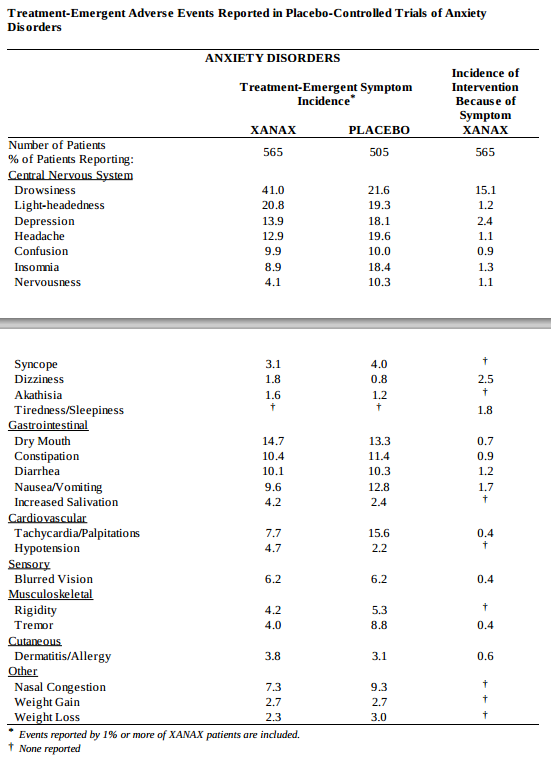
In addition to the relatively common (ie, greater than 1%) untoward events enumerated in the table above, the following adverse events have been reported in association with the use of benzodiazepines: dystonia, irritability, concentration difficulties, anorexia, transient amnesia or memory impairment, loss of coordination, fatigue, seizures, sedation, slurred speech, jaundice, musculoskeletal weakness, pruritus, diplopia, dysarthria, changes in libido, menstrual irregularities, incontinence and urinary retention.
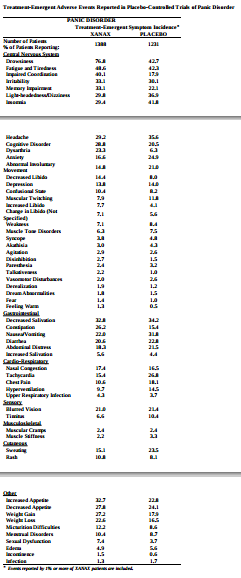
In addition to the relatively common (ie, greater than 1%) untoward events enumerated in the table above, the following adverse events have been reported in association with the use of alprazolam: seizures, hallucinations, depersonalization, taste alterations, diplopia, elevated bilirubin, elevated hepatic enzymes, and jaundice.
Panic disorder has been associated with primary and secondary major depressive disorders and increased reports of suicide among untreated patients .
Adverse Events Reported as Reasons for Discontinuation in Treatment of panic disorder in Placebo-Controlled Trials
In a larger database comprised of both controlled and uncontrolled studies in which 641 patients received alprazolam, discontinuation-emergent symptoms which occurred at a rate of over 5% in patients treated with alprazolam and at a greater rate than the placebo treated group were as follows:
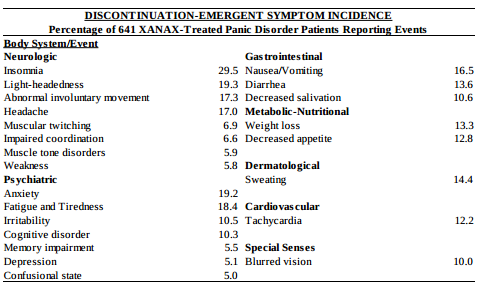
From the studies cited, it has not been determined whether these symptoms are clearly related to the dose and duration of therapy with alprazolam in patients with panic disorder. There have also been reports of withdrawal seizures upon rapid decrease or abrupt discontinuation of alprazolam Tablets .
To discontinue treatment in patients taking alprazolam, the dosage should be reduced slowly in keeping with good medical practice. It is suggested that the daily dosage of alprazolam be decreased by no more than 0.5 mg every three days . Some patients may benefit from an even slower dosage reduction. In a controlled post marketing discontinuation study of panic disorder patients which compared this recommended taper schedule with a slower taper schedule, no difference was observed between the groups in the proportion of patients who tapered to zero dose; however, the slower schedule was associated with a reduction in symptoms associated with a withdrawal syndrome.
As with all benzodiazepines, paradoxical reactions such as stimulation, increased muscle spasticity, sleep disturbances, hallucinations and other adverse behavioral effects such as agitation, rage, irritability, and aggressive or hostile behavior have been reported rarely. In many of the spontaneous case reports of adverse behavioral effects, patients were receiving other CNS drugs concomitantly and/or were described as having underlying psychiatric conditions. Should any of the above events occur, alprazolam should be discontinued. Isolated published reports involving small numbers of patients have suggested that patients who have borderline personality disorder, a prior history of violent or aggressive behavior, or alcohol or substance abuse may be at risk for such events. Instances of irritability, hostility, and intrusive thoughts have been reported during discontinuation of alprazolam in patients with posttraumatic stress disorder.
Post Introduction Reports
Various adverse drug reactions have been reported in association with the use of alprazolam since market introduction. The majority of these reactions were reported through the medical event voluntary reporting system. Because of the spontaneous nature of the reporting of medical events and the lack of controls, a causal relationship to the use of alprazolam cannot be readily determined. Reported events include: gastrointestinal disorder, hypomania, mania, liver enzyme elevations, hepatitis, hepatic failure, Stevens-Johnson syndrome, photosensitivity reaction, angioedema, peripheral edema, hyperprolactinemia, gynecomastia, and galactorrhea.
Postmarketing Experience
There is limited information regarding Alprazolam Postmarketing Experience in the drug label.
Drug Interactions
Use with Other CNS Depressants
If Alprazolam Tablets are to be combined with other psychotropic agents or anticonvulsant drugs, careful consideration should be given to the pharmacology of the agents to be employed, particularly with compounds which might potentiate the action of benzodiazepines. The benzodiazepines, including alprazolam, produce additive CNS depressant effects when co-administered with other psychotropic medications, anticonvulsants, antihistaminics, ethanol and other drugs which themselves produce CNS depression.
Use with Digoxin
Increased digoxin concentrations have been reported when alprazolam was given, especially in elderly (>65 years of age). Patients who receive alprazolam and digoxin should therefore be monitored for signs and symptoms related to digoxin toxicity.
Use with Imipramine and Desipramine
The steady state plasma concentrations of imipramine and desipramine have been reported to be increased an average of 31% and 20%, respectively, by the concomitant administration of Alprazolam Tablets in doses up to 4 mg/day. The clinical significance of these changes is unknown.
Drugs that inhibit alprazolam metabolism via cytochrome P450 3A
The initial step in alprazolam metabolism is hydroxylation catalyzed by cytochrome P450 3A (CYP3A). Drugs which inhibit this metabolic pathway may have a profound effect on the clearance of alprazolam .
Drugs demonstrated to be CYP3A inhibitors of possible clinical significance on the basis of clinical studies involving alprazolam (caution is recommended during coadministration with alprazolam)
Coadministration of fluoxetine with alprazolam increased the maximum plasma concentration of alprazolam by 46%, decreased clearance by 21%, increased half-life by 17%, and decreased measured psychomotor performance.
Coadministration of propoxyphene decreased the maximum plasma concentration of alprazolam by 6%, decreased clearance by 38%, and increased half-life by 58%.
Coadministration of oral contraceptives increased the maximum plasma concentration of alprazolam by 18%, decreased clearance by 22%, and increased half-life by 29%.
Drugs and other substances demonstrated to be CYP 3A inhibitors on the basis of clinical studies involving benzodiazepines metabolized similarly to alprazolam or on the basis of in vitro studies with alprazolam or other benzodiazepines (caution is recommended during coadministration with alprazolam)
Available data from clinical studies of benzodiazepines other than alprazolam suggest a possible drug interaction with alprazolam for the following: diltiazem, isoniazid, macrolide antibiotics such as erythromycin and clarithromycin, and grapefruit juice. Data from in vitro studies of alprazolam suggest a possible drug interaction with alprazolam for the following: sertraline and paroxetine. However, data from an in vivo drug interaction study involving a single dose of alprazolam 1 mg and steady state dose of sertraline (50 to 150 mg/day) did not reveal any clinically significant changes in the pharmacokinetics of alprazolam. Data from in vitro studies of benzodiazepines other than alprazolam suggest a possible drug interaction for the following: ergotamine, cyclosporine, amiodarone, nicardipine, and nifedipine. Caution is recommended during the coadministration of any of these with alprazolam .
Drugs demonstrated to be inducers of CYP3A
Carbamazepine can increase alprazolam metabolism and therefore can decrease plasma levels of alprazolam.
Drug/Laboratory Test Interactions
Although interactions between benzodiazepines and commonly employed clinical laboratory tests have occasionally been reported, there is no consistent pattern for a specific drug or specific test.
Use in Specific Populations
Pregnancy
Pregnancy Category (FDA): D
It should be considered that the child born of a mother who is receiving benzodiazepines may be at some risk for withdrawal symptoms from the drug during the postnatal period. Also, neonatal flaccidity and respiratory problems have been reported in children born of mothers who have been receiving benzodiazepines.
Pregnancy Category (AUS):
There is no Australian Drug Evaluation Committee (ADEC) guidance on usage of Alprazolam in women who are pregnant.
Labor and Delivery
Alprazolam has no established use in labor or delivery.
Nursing Mothers
Benzodiazepines are known to be excreted in human milk. It should be assumed that alprazolam is as well. Chronic administration of diazepam to nursing mothers has been reported to cause their infants to become lethargic and to lose weight. As a general rule, nursing should not be undertaken by mothers who must use Alprazolam.
Pediatric Use
Safety and effectiveness of Alprazolam in individuals below 18 years of age have not been established.
Geriatic Use
The elderly may be more sensitive to the effects of benzodiazepines. They exhibit higher plasma alprazolam concentrations due to reduced clearance of the drug as compared with a younger population receiving the same doses. The smallest effective dose of Alprazolam should be used in the elderly to preclude the development of ataxia and oversedation
Gender
There is no FDA guidance on the use of Alprazolam with respect to specific gender populations.
Race
There is no FDA guidance on the use of Alprazolam with respect to specific racial populations.
Renal Impairment
There is no FDA guidance on the use of Alprazolam in patients with renal impairment.
Hepatic Impairment
There is no FDA guidance on the use of Alprazolam in patients with hepatic impairment.
Females of Reproductive Potential and Males
There is no FDA guidance on the use of Alprazolam in women of reproductive potentials and males.
Immunocompromised Patients
There is no FDA guidance one the use of Alprazolam in patients who are immunocompromised.
Administration and Monitoring
Administration
Oral
Monitoring
FDA Package Insert for alprazolam contains no information regarding Drug Monitoring.
IV Compatibility
There is limited information about the IV Compatibility.
Overdosage
Clinical Experience
Manifestations of alprazolam overdosage include somnolence, confusion, impaired coordination, diminished reflexes and coma. Death has been reported in association with overdoses of alprazolam by itself, as it has with other benzodiazepines. In addition, fatalities have been reported in patients who have overdosed with a combination of a single benzodiazepine, including alprazolam, and alcohol; alcohol levels seen in some of these patients have been lower than those usually associated with alcohol-induced fatality.
The acute oral LD50 in rats is 331–2171 mg/kg. Other experiments in animals have indicated that cardiopulmonary collapse can occur following massive intravenous doses of alprazolam (over 195 mg/kg; 975 times the maximum recommended daily human dose of 10 mg/day). Animals could be resuscitated with positive mechanical ventilation and the intravenous infusion of norepinephrine bitartrate.
Animal experiments have suggested that forced diuresis or hemodialysis are probably of little value in treating overdosage.
General Treatment of Overdose
Overdosage reports with alprazolam Tablets are limited. As in all cases of drug overdosage, respiration, pulse rate, and blood pressure should be monitored. General supportive measures should be employed, along with immediate gastric lavage. Intravenous fluids should be administered and an adequate airway maintained. If hypotension occurs, it may be combated by the use of vasopressors. Dialysis is of limited value. As with the management of intentional overdosing with any drug, it should be borne in mind that multiple agents may have been ingested.
Flumazenil, a specific benzodiazepine receptor antagonist, is indicated for the complete or partial reversal of the sedative effects of benzodiazepines and may be used in situations when an overdose with a benzodiazepine is known or suspected. Prior to the administration of flumazenil, necessary measures should be instituted to secure airway, ventilation and intravenous access. Flumazenil is intended as an adjunct to, not as a substitute for, proper management of benzodiazepine overdose. Patients treated with flumazenil should be monitored for re-sedation, respiratory depression, and other residual benzodiazepine effects for an appropriate period after treatment. The prescriber should be aware of a risk of seizure in association with flumazenil treatment, particularly in long-term benzodiazepine users and in cyclic antidepressant overdose. The complete flumazenil package insert including CONTRAINDICATIONS, WARNINGS and PRECAUTIONS should be consulted prior to use.
Pharmacology

| |
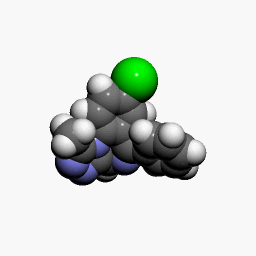
| |
Alprazolam
| |
| Systematic (IUPAC) name | |
| 8-Chloro-1-methyl-6-phenyl-4H-[1,2,4]triazolo[4,3-a][1,4]benzodiazepine | |
| Identifiers | |
| CAS number | |
| ATC code | N05 |
| PubChem | |
| DrugBank | |
| Chemical data | |
| Formula | Template:OrganicBox atomTemplate:OrganicBox atomTemplate:OrganicBoxTemplate:OrganicBoxTemplate:OrganicBoxTemplate:OrganicBoxTemplate:OrganicBox atomTemplate:OrganicBoxTemplate:OrganicBoxTemplate:OrganicBoxTemplate:OrganicBoxTemplate:OrganicBoxTemplate:OrganicBoxTemplate:OrganicBox atomTemplate:OrganicBoxTemplate:OrganicBoxTemplate:OrganicBoxTemplate:OrganicBoxTemplate:OrganicBoxTemplate:OrganicBoxTemplate:OrganicBoxTemplate:OrganicBoxTemplate:OrganicBox |
| Mol. mass | 308.765 |
| SMILES | & |
| Pharmacokinetic data | |
| Bioavailability | 80–90% |
| Metabolism | Hepatic, via Cytochrome P450 3A4 |
| Half life | Immediate release: 11.2 hours,[1] Extended release: 10.7–15.8 hours[2] |
| Excretion | Renal |
| Therapeutic considerations | |
| Pregnancy cat. |
D(US) |
| Legal status | |
| Dependence Liability | High |
| Routes | Oral, Sublingual |
Mechanism of Action
CNS agents of the 1,4 benzodiazepine class presumably exert their effects by binding at stereo specific receptors at several sites within the central nervous system. Their exact mechanism of action is unknown. Clinically, all benzodiazepines cause a dose-related central nervous system depressant activity varying from mild impairment of task performance to hypnosis.
Structure
Alprazolam Tablets contain alprazolam which is a triazolo analog of the 1,4 benzodiazepine class of central nervous system-active compounds.
The chemical name of alprazolam is 8-Chloro-1-methyl-6-phenyl-4H-s-triazolo [4,3-α] [1,4] benzodiazepine.
The structural formula is represented to the right:
Alprazolam is a white crystalline powder, which is soluble in methanol or ethanol but which has no appreciable solubility in water at physiological pH.
Each alprazolam tablet, for oral administration, contains 0.25, 0.5, 1 or 2 mg of alprazolam.
Pharmacodynamics
CNS agents of the 1,4 benzodiazepine class presumably exert their effects by binding at stereo specific receptors at several sites within the central nervous system. Their exact mechanism of action is unknown. Clinically, all benzodiazepines cause a dose-related central nervous system depressant activity varying from mild impairment of task performance to hypnosis.
Pharmacokinetics
Absorption
Following oral administration, alprazolam is readily absorbed. Peak concentrations in the plasma occur in 1 to 2 hours following administration. Plasma levels are proportionate to the dose given; over the dose range of 0.5 to 3.0 mg, peak levels of 8.0 to 37 ng/mL were observed. Using a specific assay methodology, the mean plasma elimination half-life of alprazolam has been found to be about 11.2 hours (range: 6.3–26.9 hours) in healthy adults.
Distribution
In vitro, alprazolam is bound (80 percent) to human serum protein. Serum albumin accounts for the majority of the binding.
Metabolism/Elimination
Alprazolam is extensively metabolized in humans, primarily by cytochrome P450 3A4 (CYP3A4), to two major metabolites in the plasma: 4-hydroxyalprazolam and α-hydroxyalprazolam. A benzophenone derived from alprazolam is also found in humans. Their half-lives appear to be similar to that of alprazolam. The plasma concentrations of 4-hydroxyalprazolam and α-hydroxyalprazolam relative to unchanged alprazolam concentration were always less than 4%. The reported relative potencies in benzodiazepine receptor binding experiments and in animal models of induced seizure inhibition are 0.20 and 0.66, respectively, for 4-hydroxyalprazolam and α-hydroxyalprazolam. Such low concentrations and the lesser potencies of 4-hydroxyalprazolam and α-hydroxyalprazolam suggest that they are unlikely to contribute much to the pharmacological effects of alprazolam. The benzophenone metabolite is essentially inactive.
Alprazolam and its metabolites are excreted primarily in the urine.
Special Populations
Changes in the absorption, distribution, metabolism and excretion of benzodiazepines have been reported in a variety of disease states including alcoholism, impaired hepatic function and impaired renal function. Changes have also been demonstrated in geriatric patients. A mean half-life of alprazolam of 16.3 hours has been observed in healthy elderly subjects (range: 9.0–26.9 hours, n=16) compared to 11.0 hours (range: 6.3–15.8 hours, n=16) in healthy adult subjects. In patients with alcoholic liver disease the half-life of alprazolam ranged between 5.8 and 65.3 hours (mean: 19.7 hours, n=17) as compared to between 6.3 and 26.9 hours (mean=11.4 hours, n=17) in healthy subjects. In an obese group of subjects the half-life of alprazolam ranged between 9.9 and 40.4 hours (mean=21.8 hours, n=12) as compared to between 6.3 and 15.8 hours (mean=10.6 hours, n=12) in healthy subjects.
Because of its similarity to other benzodiazepines, it is assumed that alprazolam undergoes transplacental passage and that it is excreted in human milk.
Race
Maximal concentrations and half-life of alprazolam are approximately 15% and 25% higher in Asians compared to Caucasians.
Pediatrics
The pharmacokinetics of alprazolam in pediatric patients have not been studied.
Gender
Gender has no effect on the pharmacokinetics of alprazolam.
Cigarette Smoking
Alprazolam concentrations may be reduced by up to 50% in smokers compared to non-smokers.
Drug-Drug Interactions
Alprazolam is primarily eliminated by metabolism via cytochrome P450 3A (CYP3A). Most of the interactions that have been documented with alprazolam are with drugs that inhibit or induce CYP3A4.
Compounds that are potent inhibitors of CYP3A would be expected to increase plasma alprazolam concentrations. Drug products that have been studied in vivo, along with their effect on increasing alprazolam AUC, are as follows: ketoconazole, 3.98 fold; itraconazole, 2.70 fold; nefazodone, 1.98 fold; fluvoxamine, 1.96 fold; and erythromycin, 1.61 fold .
CYP3A inducers would be expected to decrease alprazolam concentrations and this has been observed in vivo. The oral clearance of alprazolam (given in a 0.8 mg single dose) was increased from 0.90±0.21 mL/min/kg to 2.13±0.54 mL/min/kg and the elimination t1/2 was shortened (from 17.1±4.9 to 7.7 ±1.7 h) following administration of 300 mg/day carbamazepine for 10 days . However, the carbamazepine dose used in this study was fairly low compared to the recommended doses (1000–1200 mg/day); the effect at usual carbamazepine doses is unknown.
Interactions involving HIV protease inhibitors (eg, ritonavir) and alprazolam are complex and time dependent. Short-term low doses of ritonavir (4 doses of 200 mg) reduced alprazolam clearance to 41% of control values, prolonged its elimination half-life (mean values, 30 versus 13 h) and enhanced clinical effects. However, upon extended exposure to ritonavir (500 mg, twice daily), CYP3A induction offset this inhibition. Alprazolam AUC and Cmax was reduced by 12% and 16%, respectively, in the presence of ritonavir .
The ability of alprazolam to induce human hepatic enzyme systems has not yet been determined. However, this is not a property of benzodiazepines in general. Further, alprazolam did not affect the prothrombin or plasma warfarin levels in male volunteers administered sodium warfarin orally.
Nonclinical Toxicology
Carcinogenesis, Mutagenesis, Impairment of Fertility
No evidence of carcinogenic potential was observed during 2-year bioassay studies of alprazolam in rats at doses up to 30 mg/kg/day (150 times the maximum recommended daily human dose of 10 mg/day) and in mice at doses up to 10 mg/kg/day (50 times the maximum recommended daily human dose).
Alprazolam was not mutagenic in the rat micronucleus test at doses up to 100 mg/kg, which is 500 times the maximum recommended daily human dose of 10 mg/day. Alprazolam also was not mutagenic in vitro in the DNA Damage/Alkaline Elution Assay or the Ames Assay.
Alprazolam produced no impairment of fertility in rats at doses up to 5 mg/kg/day, which is 25 times the maximum recommended daily human dose of 10 mg/day.
Clinical Studies
anxiety disorders
Alprazolam Tablets were compared to placebo in double blind clinical studies (doses up to 4 mg/day) in patients with a diagnosis of anxiety or anxiety with associated depressive symptomatology. Alprazolam was significantly better than placebo at each of the evaluation periods of these 4-week studies as judged by the following psychometric instruments: Physician's Global Impressions, Hamilton anxiety Rating Scale, Target Symptoms, Patient's Global Impressions and Self-Rating Symptom Scale.
Panic disorder
Support for the effectiveness of Alprazolam in the treatment of panic disorder came from three short-term, placebo-controlled studies (up to 10 weeks) in patients with diagnoses closely corresponding to DSM-III-R criteria for panic disorder.
The average dose of Alprazolam was 5–6 mg/day in two of the studies, and the doses of Alprazolam were fixed at 2 and 6 mg/day in the third study. In all three studies, Alprazolam was superior to placebo on a variable defined as "the number of patients with zero panic attacks" (range, 37–83% met this criterion), as well as on a global improvement score. In two of the three studies, Alprazolam was superior to placebo on a variable defined as "change from baseline on the number of panic attacks per week" (range, 3.3–5.2), and also on a phobia rating scale. A subgroup of patients who were improved on Alprazolam during short-term treatment in one of these trials was continued on an open basis up to 8 months, without apparent loss of benefit.
How Supplied
Alprazolam Tablets are available as follows:
0.25 mg (white, oval, scored, imprinted "Alprazolam 0.25")
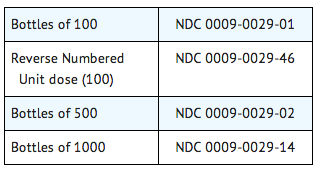
0.5 mg (peach, oval, scored, imprinted "Alprazolam 0.5")
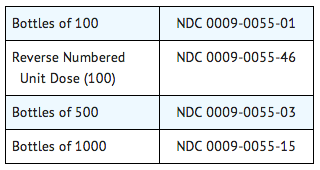
1 mg (blue, oval, scored, imprinted "Alprazolam 1.0")
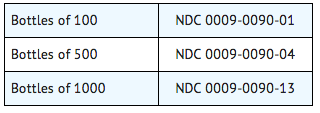
2 mg (white, oblong, multi-scored, imprinted "Alprazolam " on one side and "2" on the reverse side)

Storage
Store at controlled room temperature 20° to 25°C (68° to 77°F)
Images
Drug Images
{{#ask: Page Name::Alprazolam |?Pill Name |?Drug Name |?Pill Ingred |?Pill Imprint |?Pill Dosage |?Pill Color |?Pill Shape |?Pill Size (mm) |?Pill Scoring |?NDC |?Drug Author |format=template |template=DrugPageImages |mainlabel=- |sort=Pill Name }}
Package and Label Display Panel
{{#ask: Label Page::Alprazolam |?Label Name |format=template |template=DrugLabelImages |mainlabel=- |sort=Label Page }}
Patient Counseling Information
To assure safe and effective use of benzodiazepines, all patients prescribed Alprazolam should be provided with the following guidance.
Inform your physician about any alcohol consumption and medicine you are taking now, including medication you may buy without a prescription. Alcohol should generally not be used during treatment with benzodiazepines. Not recommended for use in pregnancy. Therefore, inform your physician if you are pregnant, if you are planning to have a child, or if you become pregnant while you are taking this medication. Inform your physician if you are nursing. Until you experience how this medication affects you, do not drive a car or operate potentially dangerous machinery, etc. Do not increase the dose even if you think the medication "does not work anymore" without consulting your physician. benzodiazepines, even when used as recommended, may produce emotional and/or physical dependence. Do not stop taking this medication abruptly or decrease the dose without consulting your physician, since withdrawal symptoms can occur. Additional advice for panic disorder patients
The use of Alprazolam at doses greater than 4 mg/day, often necessary to treat panic disorder, is accompanied by risks that you need to carefully consider. When used at doses greater than 4 mg/day, which may or may not be required for your treatment, Alprazolam has the potential to cause severe emotional and physical dependence in some patients and these patients may find it exceedingly difficult to terminate treatment. In two controlled trials of 6 to 8 weeks duration where the ability of patients to discontinue medication was measured, 7 to 29% of patients treated with Alprazolam did not completely taper off therapy. In a controlled postmarketing discontinuation study of panic disorder patients, the patients treated with doses of Alprazolam greater than 4 mg/day had more difficulty tapering to zero dose than patients treated with less than 4 mg/day. In all cases, it is important that your physician help you discontinue this medication in a careful and safe manner to avoid overly extended use of Alprazolam.
In addition, the extended use at doses greater than 4 mg/day appears to increase the incidence and severity of withdrawal reactions when Alprazolam is discontinued. These are generally minor but seizure can occur, especially if you reduce the dose too rapidly or discontinue the medication abruptly. seizure can be life-threatening.
Precautions with Alcohol
Inform your physician about any alcohol consumption and medicine you are taking now, including medication you may buy without a prescription. Alcohol should generally not be used during treatment with benzodiazepines.
Brand Names
There is limited information regarding Alprazolam Brand Names in the drug label.
Look-Alike Drug Names
There is limited information regarding Alprazolam Look-Alike Drug Names in the drug label.
Drug Shortage Status
Price
References
The contents of this FDA label are provided by the National Library of Medicine.
- ↑ "Alprazolam (Alprazolam) Clinical Pharmacology – Prescription Drugs and Medications". RxList. First DataBank. July 2008.
- ↑ "Alprazolam XR (Alprazolam) Clinical Pharmacology – Prescription Drugs and Medications". RxList. First DataBank. July 2008.
{{#subobject:
|Label Page=Alprazolam |Label Name=Alprazolam_label_01.jpg
}}
{{#subobject:
|Label Page=Alprazolam |Label Name=Alprazolam_label_02.jpg
}}
{{#subobject:
|Label Page=Alprazolam |Label Name=Alprazolam_label_03.jpg
}}
{{#subobject:
|Label Page=Alprazolam |Label Name=Alprazolam_label_04.jpg
}}
{{#subobject:
|Label Page=Alprazolam |Label Name=Alprazolam_panel_01.png
}}
{{#subobject:
|Label Page=Alprazolam |Label Name=Alprazolam_panel_02.png
}}
{{#subobject:
|Label Page=Alprazolam |Label Name=Alprazolam_panel_03.png
}}
{{#subobject:
|Label Page=Alprazolam |Label Name=Alprazolam_panel_04.png
}}